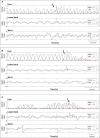Detection of Real-World Trips in At-Fall Risk Community Dwelling Older Adults Using Wearable Sensors
- PMID: 32984385
- PMCID: PMC7492551
- DOI: 10.3389/fmed.2020.00514
Detection of Real-World Trips in At-Fall Risk Community Dwelling Older Adults Using Wearable Sensors
Abstract
Background: Near-falls such as a trip, slip, stumble, or misstep involve a loss of balance (LOB) that does not result in a fall, occur more frequently than actual falls, and are associated with an increased fall risk. To date, studies have largely involved detection of simulated laboratory LOBs using wearable devices in young adults. Data on the detection of and kinematics of naturally occurring LOBs in people at high risk of falling are lacking. This may provide a new way to identify older adults at high risk for falls. We aimed to explore key body kinematics underlying real-world trips in at-fall risk community dwelling older adults wearing inertial measurement units (IMU). Methods: Five community-dwelling older adults with a history of falls who reported trips during the study period participated. They wore a voice recorder and 4 IMUs mounted on feet, lower back and wrist for two consecutive weeks to provide a record of the context and timing of LOB events. Sensor data prior to time-stamped voice recording of a trip were processed in order to visually identify unusual foot trajectories and lower back and arm orientations. Then, data of feet, lower back and wrist position and orientation were combined to create a three-dimensional animation representing the estimated body motion during the noted time segments in order to corroborate the occurrence of a trip. Events reported as a trip by the participant and identified as a trip by a researcher, blinded to voice recordings description, were included in the final analysis. Results: A total of 18 trips obtained from five participants were analyzed. Twelve trips occurred at home, three outside and for three the location was not reported. Trips were identified in the sensor data by observing (1) additional peaks to the typical foot velocity signal during swing phase; (2) increased velocity of the contralateral foot and (3) sharp changes in lower back pitch angles. Conclusions: Our approach demonstrates the feasibility of identifying and studying the mechanisms and context underlying trip-related LOBs in at-fall risk older adults during real world activities.
Keywords: accelerometers; balance; inertial measurement units; monitoring; near-falls; walking.
Copyright © 2020 Handelzalts, Alexander, Mastruserio, Nyquist, Strasburg and Ojeda.
Figures




References
-
- Del Din S, Galna B, Godfrey A, Bekkers EMJ, Pelosin E, Nieuwhof F, et al. . Analysis of free-living gait in older adults with and without Parkinson's disease and with and without a history of falls: identifying generic and disease-specific characteristics. J Gerontol A Biol Sci Med Sci. (2019) 74:500–6. 10.1093/gerona/glx254 - DOI - PMC - PubMed
Grants and funding
LinkOut - more resources
Full Text Sources

